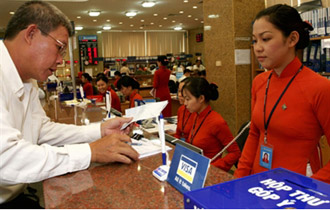VietNamNet Bridge – The State Bank of Vietnam has announced that besides the nine weak commercial banks which are undergoing the restructuring process, it has found another 8 weak credit institutions for the compulsory restructuring.

The post-hot growth period
Vietnam once experienced the period when the annual credit growth rate was as high as 30-40 percent, which helped the banking sector make fat profit.
The attractiveness of the investments in the banking sector not only lied in the huge profits, but also from the power: banks’ owners could use huge capital to fund their businesses’ projects.
ACB, Sacombank, Vietcombank, Eximbank and Dong A Bank made big leaps in their development in the period with the total assets and stockholder equity increasing by tens of times just within a short time.
However, in return for the overheated growth, commercial banks have caught a lot of problems. The complicated cross-ownership relation among banks, between banks and businesses has led to the management uncontrollability. A high percentage of total assets and banks’ stockholder equities is believed to be the “virtual capital.”
A lot of new banks were set up to act as the suppliers of capital to the businesses of the banks’ owners and big shareholders. Nguyen Duc Kien, a founding shareholder of ACB used tens of trillions of dong from ACB and other banks to lend to his businesses.
Analysts commented that the golden age of the banking sector is over. The annual credit growth rates were modest at 10 percent over the last three year, while a lot of banks report the sharp falls in profits or losses.
Taking loss is not the only problem banks suffer. They have been burdened with big bad debts as well. Commercial banks’ reports said their bad debt ratio by October 2013 had been less than 5 percent. The banks which are considered “strong” reportedly have the bad debt ratio of below 3 percent.
However, the State Bank admitted that if the debt restructuring in accordance with the Decision No. 780 was not carried out, the bad debt ratio of the national economy would be 15 percent.
“Strong” banks will also experience the restructuring
Le Hung Dung, President of Eximbank, in a recent meeting with the local press, said that banks now are like farmers, who have to work hard on the rice fields to collect small sums of money. He said that the period when banks could easily make profit from the gold, bond, share trading and from the large margin between the lending and deposit interest rates is over.
Not only weak banks have to undergo the restructuring, but strong banks also have to improve and renovate themselves.
A lot of banks have cut down thousands of workers in their restructuring plan to cut down expenses. Eximbank, for example, has transferred 300 workers from the headquarter to the sales units, while ACB has laid off 1,000 workers and cut down wages.
A finance expert commented that banks previously entertain illusions about the bright prospect of the finance investments. Therefore, they set up securities companies and excessively poured money into real estate projects. And now is the time for them to pay a heavy price for this. Even the banks considered as healthy are not surely 100 percent safe.
Tien Phong